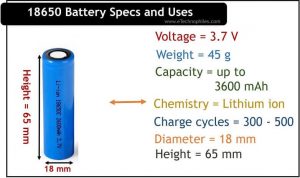Last updated on April 3rd, 2024 at 10:32 am
It is a secondary lithium-ion battery that has a nominal voltage of 3.7 V, 2600 mAh capacity, and 18 mm in diameter and 65 mm tall. It offers up to 1000 charge cycles and resembles the shape of a standard AA battery but offers extremely superior features and performance to AA batteries.
This battery is a high-capacity lithium-ion battery that is often used in high-drain devices like flashlights, laptops, DVD players, iPods, etc.
They are rechargeable batteries that are highly preferred in high-current applications. These batteries also dominate other batteries in terms of battery life and energy density. Moreover, the ease of use makes these batteries very popular in the market.
Table of Contents
How to identify 18650 terminals?
Usually, there will be +Ve and -Ve markings on the battery itself. If not, it’s easy to identify the terminals. The negative terminal is the plane side whereas the positive terminal has a different color circular layer around it and has less surface area than the -ve terminal.
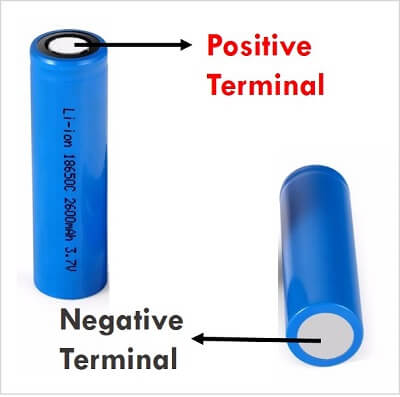
History and performance of 18650 battery
The 18650 battery is 65mm tall and has 18 mm thickness or diameter, hence the name 18650.
The popular 18650 battery is a successful milestone in the evolution of lithium-ion batteries. The first lithium-ion battery was invented in the 1970s and mass-produced by Sony. As per the statistics, in 2011 lithium-ion batteries were at the top with about 66% of the total sales.
These batteries are very popular for their light weight and outstanding discharge properties. It offers a high depth of discharge even up to 100% and still retains the capacity to fully recharge. A relatively small internal resistance is the reason behind this stable performance. Moreover, 18650 batteries are pollution-free and environment-friendly. Thus they are safe to use.
Like all other lithium-ion batteries, This battery is also advised to be used with a protection circuit board to protect the battery against the damages caused by over-charge and over-discharge. They are also free from the memory effect that gradually reduces the battery capacity over the years.
Are AA batteries the same as 18650?
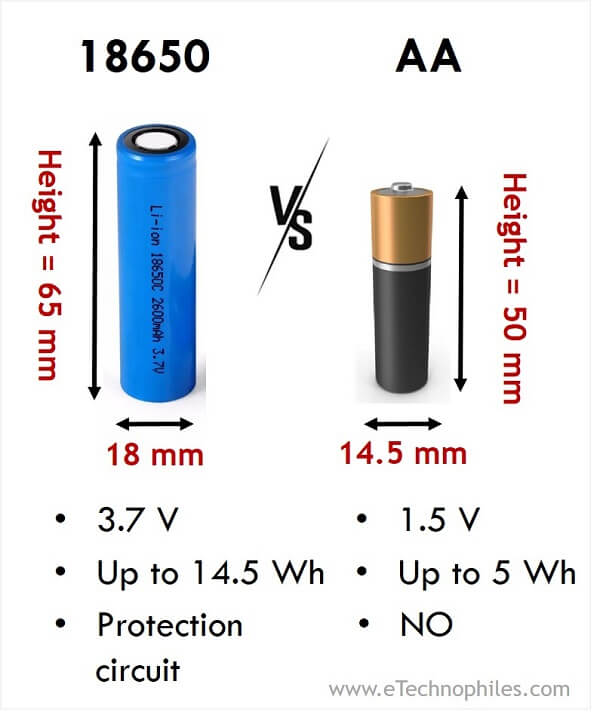
No. Both these batteries are similar in shape. However, they significantly differ in size, chemistry, and performance. AA batteries are alkaline, non-rechargeable, and low-drain batteries whereas 18650 batteries are lithium-ion, rechargeable, and high-drain batteries.
18650 battery equivalent
There are not many exact equivalents for 18650 batteries. The batteries available in different chemistries can be used interchangeably. They are LiFePO4, LiMn2O4, LiNiMnCoO2, LiNiCoAlO2, LiNiCoO2, and LiCoO2 . All these batteries vary slightly in nominal voltage and capacity. The other features are relatively the same.
21700, 26650, 16340, and 14500 are some batteries that can be replaced with 18650 in your everyday projects. However, there are several factors to consider: the protection circuit may require some changes, the dimensions of the battery, load requirement, and whether only one 18650 cell needs to be replaced or all.
Note: Replacing just one cell can seriously affect the circuit’s health since batteries with different capacities will be connected.
Types of 18650 batteries
Different types of 18650 batteries are available in the market. The classification happens from different perspectives also. Let us have a look.
18650 batteries in different chemical combinations
LiFePO4, LiMn2O4, LiNiMnCoO2, LiNiCoAlO2, LiNiCoO2, and LiCoO2 are the popular variants of 18560 batteries based on chemical composition.
- LiFePO4 is a Lithium iron phosphate battery which is also known as IFR, LFP or Li-phosphate.
- LiMn2O4 is a Lithium manganese oxide battery which is also known as IMR, LMO or Li-manganese. These are mostly used for high current drain purposes.
- LiNiMnCoO2 is a Lithium manganese nickel battery which is also known as INR or NMC. They are preferred in high current drain applications.
- LiNiCoAlO2 is a Lithium nickel cobalt aluminum oxide battery which is also known as NCA or Li-aluminum.
- LiNiCoO2 is a Lithium nickel cobalt oxide battery and is also known as NCO.
- LiCoO2 which is Lithium cobalt oxide, also known as ICR LCO Li-cobalt.
Protected vs unprotected 18650 batteries
Depending on the usage of protection circuits, there are two types of 18650 batteries; protected and unprotected. Such a provision exists because overcharging lithium-ion batteries may cause fire and damage to the connected devices. Let’s move into the details.
1. Protected 18650 Batteries: These batteries are embedded with an electronic circuit that stops the cell from being overcharged, or over-discharged. They normally have a “button top” to differentiate them from ordinary batteries.
Thus these batteries are less likely to overheat or burst and are safer.
Some Protected 18650 cells:
Orbtronic 18650 is one such battery that is a high drain, high capacity protected cell. It offers a capacity of 3500mAh and is more expensive than any unprotected 18650 cells.
LG18650b is a protected cell with a 3400mAh capacity and is less expensive than Orbtronic 18650.
2. Unprotected 18650 Batteries: These are normal lithium-ion batteries that do not have an extra mechanism to monitor and stop overheating. They usually have a flat top. Since full-fledged safety is not ensured in these batteries, they are usually not recommended for use.
But if necessary, we can use these batteries only with an externally monitored charging scenario. Due to the absence of monitoring circuitry, they are cheaper than protected batteries.
Applications
These batteries are popular for applications that require a continuous and high current drain. Thus they can meet the high power demands of such devices that only a few battery technologies can satisfy.
Since they offer high reliability, long run times, and large charge cycles, their demand again increased. The popular applications include
- Flashlights
- Laptops
- Electric cars
- Digital cameras
- Cordless Phones
- Small DRONES
- Tablet PC GPS
- iPod
- DVD
- MP4 Player
- Mobile backup power supply/Power bank
- Audiovisual equipment
- Cellular phones
- Office automation
- Notebook PC’s
- PDA’s
- Vaping devices
Specifications
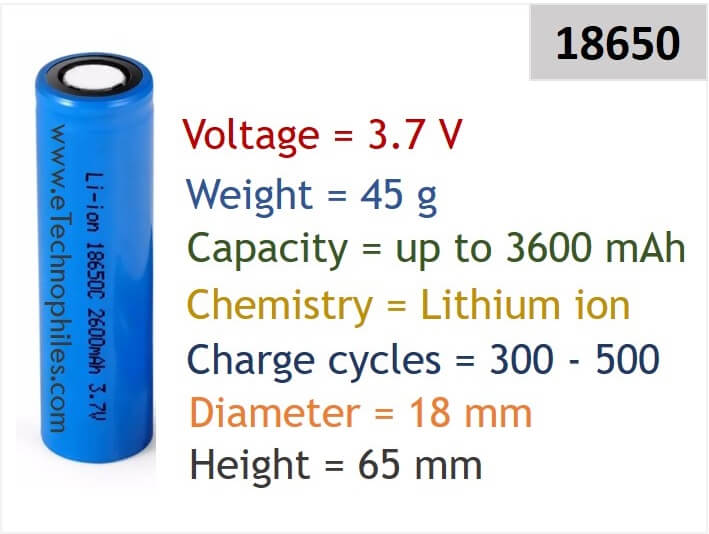
The table lists the important features of an 18650 battery.
| Feature | Value |
|---|---|
| Shape | Cylindrical |
| Chemistry | Lithium-ion |
| Nominal Voltage | 3.7V |
| Diameter | 18 mm |
| Thickness | 65 mm |
| Capacity | 2300 to 3600 mAh |
| Weight | 45 g |
| Storage Temperature | -20 ~ +50°C |
| Charge Cycles | 300 – 500 |
| Charge Time | ~ 4 Hours |
This coin cell has a nominal voltage of 3.7 V and a capacity of up to 3600 mAh. It offers up to 1000 charge cycles.
Dimensions
This battery is 18 mm in diameter and 65 mm tall.
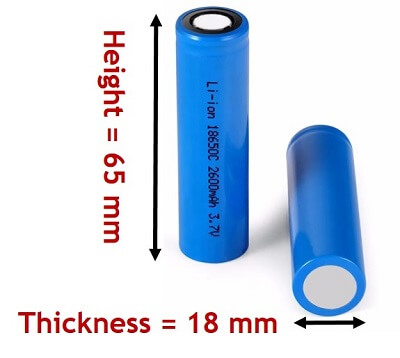
Detailed dimensions of this battery are given in the image below:
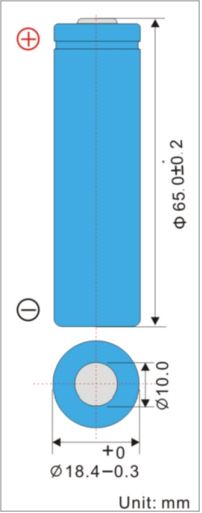
Read also: Important Battery Terms & Characteristics Explained (with Examples)
What are the safety concerns of the 18650 battery?
Although these batteries are highly efficient and durable, the risk of overheating is a serious safety concern for them. Thus proper care should be taken while handling as well as disposing of these batteries.
The primary causes of this overheating are overcharging and over-discharging. This causes excess gas accumulation inside the cell which results in fire and explosion. This is where the protection circuit gets relevant.
Several electronic zones provide battery drop-off points to collect the damaged and dead batteries. They will send these batteries to recycling centers where the batteries will be recycled or disposed of harmless. This is the appropriate and environment-friendly method to remove unwanted lithium-ion batteries.
FAQs
What is the highest capacity 18650 battery?
The highest capacity shown by the 18650 battery is 3500mAh. Molicel M35A 18650 battery offers this incredible consistency.
What happens if you overcharge an 18650 battery?
Overcharging heats the battery. This causes gas accumulation in the cells which in turn increases pressure and finally results in thermal runaway. External fire and explosions are the after-effects that will damage the connected devices and even harm human life.
The protection circuit frequently monitors the voltage, current, and temperature of the battery and terminates charging/discharging if any suspicious situation is noted.
How Long Does the 18650 Battery Last?
18650 battery is typically a long-life battery. This is one of its highlighted features too. Apart from ordinary batteries, they operate at high capacity even after 300 charge cycles. Most 1850 batteries support 300-500 charge cycles on average. But if wisely handled, it can be recharged up to 1000 cycles!
